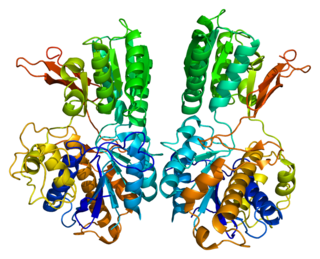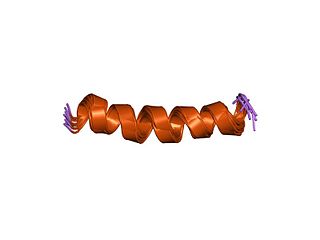| glutamate receptor, ionotropic, N-methyl D-aspartate-like 1B | |
|---|---|
| Identifiers | |
| Symbol | GRINL1B |
| Entrez | 84534 |
| HUGO | 15712 |
| OMIM | 608311 |
| UniProt | Q9BZD3 |
| Other data | |
| Locus | Chr. 4 q12 |
Glutamate receptor, ionotropic, N-methyl D-aspartate-like 1B, also known as GRINL1B, is a human gene. [1] The protein encoded by this gene is a subunit of the NMDA receptor.

In biology, a gene is a sequence of nucleotides in DNA or RNA that codes for a molecule that has a function. During gene expression, the DNA is first copied into RNA. The RNA can be directly functional or be the intermediate template for a protein that performs a function. The transmission of genes to an organism's offspring is the basis of the inheritance of phenotypic trait. These genes make up different DNA sequences called genotypes. Genotypes along with environmental and developmental factors determine what the phenotypes will be. Most biological traits are under the influence of polygenes as well as gene–environment interactions. Some genetic traits are instantly visible, such as eye color or number of limbs, and some are not, such as blood type, risk for specific diseases, or the thousands of basic biochemical processes that constitute life.

Proteins are large biomolecules, or macromolecules, consisting of one or more long chains of amino acid residues. Proteins perform a vast array of functions within organisms, including catalysing metabolic reactions, DNA replication, responding to stimuli, providing structure to cells and organisms, and transporting molecules from one location to another. Proteins differ from one another primarily in their sequence of amino acids, which is dictated by the nucleotide sequence of their genes, and which usually results in protein folding into a specific three-dimensional structure that determines its activity.

In structural biology, a protein subunit is a single protein molecule that assembles with other protein molecules to form a protein complex. Some naturally occurring proteins have a relatively small number of subunits and therefore described as oligomeric, for example hemoglobin or DNA polymerase. Others may consist of a very large number of subunits and therefore described as multimeric, for example microtubules and other cytoskeleton proteins. The subunits of a multimeric protein may be identical, homologous or totally dissimilar and dedicated to disparate tasks.


















